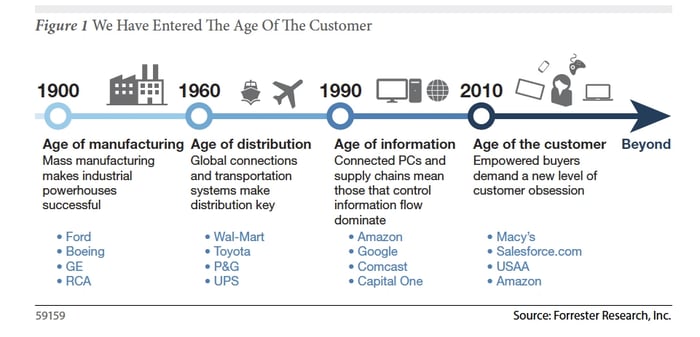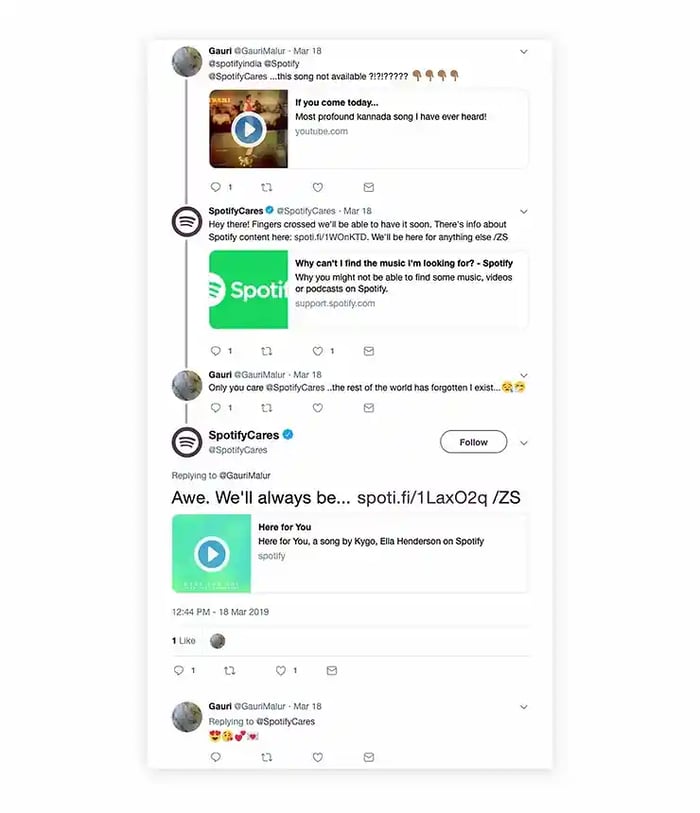Nowadays, brands can be "canceled" almost instantly after posting a rogue tweet or getting caught up in a PR scandal. And, in some cases, it only takes one poor customer experience for things to snowball into a viral incident.
Why?
Because customers are more connected than ever before. If you have a bad experience with a brand, you can post it on social media, and your hundreds of followers can see and share it. If your post gains traction and it starts to go viral, that couple hundred followers can quickly turn into a few thousand or even a million.
On a smaller scale, third-party review sites like Yelp and Google empower consumers to share experiences they've had with different businesses. That way, people who are interested in these brands can read the reviews and decide whether or not they want to shop at a certain company. Reading customer reviews has become so routine for most consumers that nearly 93% of all purchase decisions are now influenced by online reviews.
But, consumers didn't always have this much influence over their customer journey. Businesses once dominated the narrative and dictated what customers heard and saw from the brand. Consumers couldn't reach out in real-time and had to rely on marketing campaigns to get their information about a company.
Let's explore how this relationship evolved into what it is today in the section below.
How Did We Get to the Age of the Customer?

Age of Manufacturing
At the beginning of the 1900s, Europe and the United States were coming to the end of the Industrial Revolution, and companies with massive manufacturing operations were dominating their industries. If you wanted to discover a new company or product, you'd likely find it in your local town or hear about it from your neighbor. You also had to go to the store to purchase it or order it from the company's mail-delivered catalog.
In this system, companies dictated the entire buying process, and any information published about the brand was promoted by the company. Since mass-distribution wasn't available, it was still important for brands to produce high-quality products and ensure customer satisfaction. Since they could only reach customers in their immediate areas, they needed to make sure these people were happy and willing to return to the business.
Age of Distribution
In the 1960s, modern transportation made it possible to deliver products all over the world. Businesses are no longer limited to their local geographical markets and can start to think globally in terms of distribution.
The byproduct of this is that customer satisfaction took a backseat to quantitative data like revenue and customer acquisition. Since businesses could reach more customers, they could afford to make more mistakes. After all, there was no internet for customers to complain. They could only go back to the business to report the issue or tell their close friends about their dissatisfaction.
What this did is tip the scales in favor of businesses even more. Now they controlled a one-way communication system, so they could say whatever they wanted about the brand and didn't really have to back it up. There was also no social media or internet for customers to share information, so businesses were held less accountable for poor customer experiences.
Age of Information
The scales started to tip in the opposite direction once we entered the "Age of Information." Here, consumers had access to the internet and could finally discover content that's not created by a business. This opened the door to things like third-party review sites and community forums where customers could voice their opinions about different products and companies.
At this point, the power between businesses and customers still isn't even. While customers can now share some information with each other, it's not in real-time nor is it organized enough to make a real impact on the business. While some companies are using the internet to analyze customer feedback, most are leveraging it as a marketing tool to acquire new customers.
Age of the Customer
Forrester marks the Age of the Customer as 2013, but we really entered this era in 2008 with the rise in popularity of social media platforms like Facebook and Twitter. Facebook and Twitter suddenly created a world where consumers from all over the world could talk with each other about their experiences with different brands. They could reply to marketing messages in real-time and post their own content on a brand's social media page.
This significantly levels the playing field because customers can now openly talk about their experience with a brand and share it for everyone to see. If a customer has a poor experience, they don't just tell the business. They tweet about it to their friends who reply and retweet until hundreds of people know about it. This puts brands in a tricky spot where they're not just dealing with one customer's opinion, but potentially thousands.
Now that we've explained what the age of the customer is, you might be wondering what it means for your business. We'll talk more about that in the section below.
What Does the Age of the Customer Mean for Businesses?
Consumers Have More Influence Than Before.
The most important takeaway from the Age of the Customer is that consumers have more influence over the buying process than they've had in the past. Traditionally it's been businesses that have had complete control over the manufacturing, distribution, and advertising of their products. Now, customers have resources of their own that they can use to gain leverage on a brand.
For example, social media is a great tool for getting a brand's attention online. Here's one example from a Spotify customer who requested a new song be added to the service.

Not only does Spotify offer a speedy response to the customer's request, but you also have to love the clever addition of the "Here for You" song.
Experiences like this are now essential to customer service. If your brand has a social media account, customers won't be shy about sharing their opinions or concerns.
Brands Need to Embrace Two-Way Communication.
Part of consumers having more power means they can openly communicate with brands in real-time — and, they can do it in groups, too.
We mentioned one way with social media, but another way is through customer reviews. It's never been easier to share your experience with a brand online, and there are plenty of review sites where you can write as much as you want about a company. You can even do it anonymously, too, if you really want to criticize a brand.
Additionally, today's cell phones can film and take pictures of everything, and they can share this content with a mass audience at a moment's notice. You don't even have to write about your experience because you can just take a picture or video instead. These images will typically make for more compelling content anyways, causing more of an impact on a brand's reputation.
If brands want to maintain a positive image, they need to be willing to respond to customer complaints online — even when they're not reported directly to your support team. Doing so will help you reduce customer churn and may even turn some of those negative reviews into positive ones.
If You Want to Earn Your Customers' Trust, You Have to Put Their Needs First.
In the age of the customer, consumers are like that ex that you want to get back together with, but they're not sure if you've really changed. They want to trust that your business has grown up and is now ready to commit to a mutually beneficial relationship, but your history together just makes it difficult for them to trust you. They need to know that your business is genuine and has sincere intentions before they can move forward.
Earning your customers' trust comes from consistently providing excellent customer service. That means putting your customers' needs first, even when that comes at the expense of your business. It's easy to be nice to customers when they're happy with your company, but the real test is when they need something that falls outside your scope of support.
The payoff, though, is that loyal customers will stick with a brand that they trust. 69% of consumers will remain loyal to their trusted brands even if their competitors are receiving better reviews. They'll also advocate for these brands, with 76% saying they'll recommend companies they trust when asked for a referral.
Customers Are Advisors, Not Decision-Makers.
Before you rush away from this post and redesign your entire business to revolve around the customer experience, remember that customers are ultimately advisors and not real decision-makers at your company. They can offer some sound advice about how you can improve your products and services, but they're not working at your company every day like you and your team are.
With this in mind, you need to be aware that you're not overreacting to every piece of negative feedback that your team receives. If you get a negative review, record it, and log it in your help desk so you can analyze it later. If you start to see the same reviews piling up, then it may be time to consider a change.
Great Customer Service Is a Competitive Advantage.
The good news is, if you do provide excellent customer service, it can be a competitive advantage that gives you a leg up in your industry. In fact, research shows that 86% of people are willing to pay more for a great customer experience than a poor one. Great customer service elevates the attractiveness of your business, so even if your product is a little more expensive than your competitors, your service can be the great equalizer that swings indecisive buyers.
Take this Zappos ad, for example.
Zappos uses a real customer story to promote how great it's customer service is. Zappos knows its target audience values high-quality service, so it's putting its support team front and center when promoting its brand. This is a very effective approach because viewers can trust these ads since they're sourced from real customer stories.
What Follows the Age of the Customer?
If we revisit the timeline that we described earlier in this post, you might wonder what will come after the Age of the Customer. While it's hard to predict the future, we can surmise that elements of this era will continue to influence businesses over time. After all, we still use manufacturing to create products, modern transportation to distribute globally, and the internet to research and discover new brands.
Businesses will likely continue to put the customer first and embrace a two-way communication system as we move closer to a more equal balance of power between brands and consumers.
For more ways to leverage customer service at your business, read how to generate customer value.
Customer Experience





![Is The Customer Always Right? [What It Means + Why It Matters]](https://53.fs1.hubspotusercontent-na1.net/hubfs/53/customer-is-always-right-origin-1-20250202-6448090.webp)





